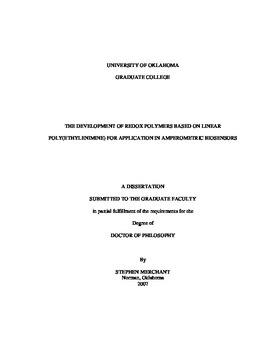| dc.contributor.advisor | Schmidtke, David W., | en_US |
| dc.contributor.author | Merchant, Stephen. | en_US |
| dc.date.accessioned | 2013-08-16T12:21:02Z | |
| dc.date.available | 2013-08-16T12:21:02Z | |
| dc.date.issued | 2007 | en_US |
| dc.identifier.uri | https://hdl.handle.net/11244/1316 | |
| dc.description.abstract | The second polymer synthesized was hexylferrocenyl linear poly(ethylenimine) [HxFc-LPEI]. By extending the ferrocene group further away from the polymer backbone HxFc-LPEI eliminates the proximity issue, particularly the morphological confinement in crosslinked films. This dramatically improves both the electrochemical response and the sensor response with respect to stability. The cyclic voltammograms indicate no apparent multiple microenvironments as only single wave redox behavior is observed. Sensor responses with HxFc-LPEI suggest that extending the ferrocene redox couple from the backbone results in less efficient electrical communication with the enzyme. While, still producing competitive responses to glucose (∼ 600 muA/cm2), the benefit of the longer tether on the ferrocene couple is observed in a ten-fold increase in the long term stability of the sensor. The half life of HxFc-LPEI based glucose sensors is 30 hours while the half life of MeFc-LPEI based sensors is only 3 hours. | en_US |
| dc.description.abstract | Redox polymers based on linear poly(ethylenimine) were synthesized for use in amperometric biosensors. The first polymer synthesized for this work was methylferrocenyl linear poly(ethylenimine) [MeFc-LPEI]. The solution electrochemistry of this material exhibited redox potential shifts in the opposite direction of what is normally observed for ferrocene modified amines. It was demonstrated here that counter ion effects, in conjunction with the proximity of the ferrocene group to the polymer backbone, may be responsible for the counterintuitive potential shifts. Crosslinked films of this polymer also displayed abnormal behavior. Under certain conditions the films would undergo oxidative degradation which resulted in electrochemical and sensors instability. This phenomena is probably also related to the proximity of the ferrocene group to the polymer backbone, in addition to the morphological changes that occur in crosslinked films. Nonetheless, this material was shown to produce the highest responding glucose sensors (∼ 1200 muA/cm 2) reported confirming our hypothesis that such materials could be developed into effective sensor components. | en_US |
| dc.format.extent | xv, 113 leaves : | en_US |
| dc.subject | Biosensors. | en_US |
| dc.subject | Ferrocene. | en_US |
| dc.subject | Engineering, Chemical. | en_US |
| dc.subject | Blood sugar monitoring. | en_US |
| dc.subject | Polymers in medicine. | en_US |
| dc.title | The development of redox polymers based on linear poly(ethylenimine) for application in amperometric biosensors. | en_US |
| dc.type | Thesis | en_US |
| dc.thesis.degree | Ph.D. | en_US |
| dc.thesis.degreeDiscipline | School of Chemical, Biological and Materials Engineering | en_US |
| dc.note | Source: Dissertation Abstracts International, Volume: 69-01, Section: B, page: 0492. | en_US |
| dc.note | Adviser: David W. Schmidtke. | en_US |
| ou.identifier | (UMI)AAI3296163 | en_US |
| ou.group | College of Engineering::School of Chemical, Biological and Materials Engineering | |
